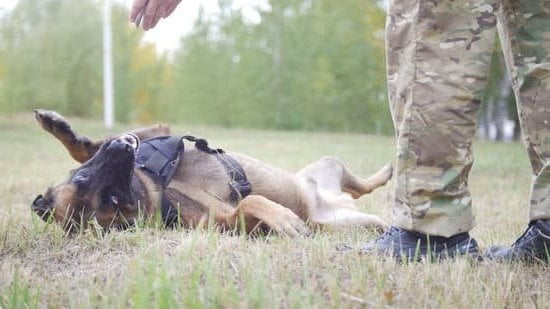Why do dogs bark? Understanding the reasons behind their barking behavior is crucial in addressing and training them not to bark excessively, especially when outdoors. In this article, we will delve into the essential steps on how to train your dog not to bark outside effectively.
Dogs use barking as a form of communication, but excessive barking can lead to disturbances and annoyances for both the pet owner and neighbors. It is essential to recognize the triggers that prompt your dog to bark when they are outside, whether it be other animals, strangers passing by, or simply boredom.
Training your dog not to bark outside involves positive reinforcement techniques such as using treats and praise as rewards for desirable behaviors. Consistency in training is key to success, as establishing a routine and sticking to it will help your dog understand what is expected of them. By redirecting their behavior towards more appropriate actions and ensuring they are adequately exercised and mentally stimulated, you can effectively reduce your dog’s outdoor barking.
Identifying the Triggers
Dogs bark for various reasons, and as a responsible pet owner, it is essential to identify the triggers that cause your dog to bark excessively when outside. One common trigger is territorial behavior, where your dog feels the need to protect their space from perceived threats like other animals or strangers passing by. Understanding this can help you address the root cause of the barking and work on training your dog not to react in such situations.
Another trigger for barking could be boredom or loneliness, especially if your dog is left alone in the yard for extended periods. In this case, providing enough mental stimulation and exercise can go a long way in preventing excessive barking. Ensuring your dog has toys to play with and engaging activities can keep them occupied and less likely to bark incessantly.
Additionally, some dogs may bark due to fear or anxiety triggered by loud noises, unfamiliar people, or even other animals. By recognizing these triggers, you can gradually desensitize your dog through exposure in a controlled environment. Positive reinforcement techniques play a crucial role in helping your dog understand that remaining calm in those situations is desirable behavior. Consistency in training and patience are key elements in successfully teaching your dog not to bark outside when faced with these triggers.
| Triggers | Training Solutions |
|---|---|
| Territorial Behavior | Work on desensitizing your dog through controlled exposure |
| Boredom/Loneliness | Provide mental stimulation and exercise to keep your dog occupied |
| Fear/Anxiety | Use positive reinforcement techniques to address fears and anxieties |
Positive Reinforcement
Choosing the Right Treats
When it comes to using positive reinforcement to train your dog not to bark outside, choosing the right treats is essential. Opt for high-value treats that your dog loves and is willing to work for. These can be small pieces of cooked chicken, cheese, or commercial dog treats. The key is to find something that will truly motivate your furry friend to focus on you and follow your commands.
Timing Is Everything
One crucial aspect of positive reinforcement training is timing. It’s important to reward your dog immediately after they exhibit the desired behavior of not barking when outside. This instant reinforcement helps your dog make the connection between their actions and the reward they receive. Remember, dogs live in the moment, so swift and consistent rewards are key in their learning process.
Consistency in Training
Consistency plays a significant role in positive reinforcement training. Make sure that every time you catch your dog not barking unnecessarily outside, you reward them with treats and praise. By being consistent in your approach, your furry companion will quickly understand what behavior is expected from them. Additionally, consistency also means using the same command or cue each time you want to reinforce their good behavior of staying quiet while outdoors.
Consistency Is Key
Setting a Training Schedule
One of the most important aspects of training your dog not to bark outside is establishing a consistent training schedule. Dogs thrive on routine, so having set times each day dedicated to training can help reinforce desired behaviors. Whether it’s in the morning before going for a walk or in the evening before dinner, find a time that works best for you and your furry friend.
Reinforcing Rules and Commands
Consistency also means reinforcing the rules and commands you set for your dog. If you want your dog to stop barking at passersby, reward them with treats and praise when they remain quiet. However, if they do start barking, provide a firm “quiet” command and redirect their attention. By consistently enforcing these rules, your dog will understand what is expected of them.
Sticking to the Plan
It’s easy to become lax with training over time, especially when progress seems slow. However, staying committed to the plan is crucial in successfully training your dog not to bark outside. Remember that consistency is key in any type of training, and it may take some time before you see significant changes in your dog’s behavior. Be patient, stay persistent, and trust the process.
By following a consistent routine, reinforcing rules and commands, and staying committed to your training plan, you’ll be on your way to effectively teaching your dog not to bark excessively outside. Remember that every dog is unique and may respond differently to various training methods, so don’t be afraid to seek professional help if needed. Consistency paired with patience and persistence will lead to a well-behaved furry companion who knows when it’s appropriate to keep quiet.
Redirecting Behavior
Dogs bark for various reasons, whether it is to alert you of something, communicate with other animals, or simply out of boredom. However, excessive barking can be a nuisance, especially when it occurs outdoors. To address this issue, it is important to train your dog not to bark excessively while outside. Redirecting your dog’s behavior by teaching them alternative actions can be an effective way to curb their barking tendencies.
One effective method to redirect your dog’s behavior is by using commands like “Quiet” or “Enough” when they start barking. When they stop barking upon hearing the command, reward them with treats and praise. This positive reinforcement technique helps your dog associate not barking with receiving rewards, reinforcing the desired behavior.
Another alternative behavior that can replace barking is teaching your dog to fetch a toy or perform a trick whenever they feel the urge to bark unnecessarily. By redirecting their focus onto something else that is engaging and fun, you can help them break the habit of excessive barking. Consistency in practicing these alternative behaviors is key to ensuring your dog learns not to bark unnecessarily while outdoors.
| Method | Effectiveness |
|---|---|
| Using commands like “Quiet” | Highly effective when paired with positive reinforcement |
| Engaging in fetch or tricks | Effective in redirecting focus away from barking |
Exercise and Mental Stimulation
Dogs, just like humans, require physical and mental stimulation to stay healthy and happy. When a dog doesn’t get enough exercise or mental engagement, it can result in excessive barking as a way to release pent-up energy or boredom. Therefore, ensuring that your furry friend is adequately stimulated is crucial in reducing their barking behavior. Here are some ways you can incorporate exercise and mental stimulation into your dog’s routine:
- Take your dog for regular walks or runs to burn off excess energy
- Engage in interactive play sessions such as fetch or tug-of-war to keep them physically active
- Provide puzzle toys or treat-dispensing toys that challenge their minds and keep them entertained
- Rotate their toys regularly to prevent boredom and keep their interest piqued
In addition to physical exercise, mental stimulation is equally important for dogs. Training sessions, obedience classes, and new tricks can all provide mental challenges that will help keep your dog’s mind sharp. By keeping both their body and brain engaged, you can significantly reduce their urge to bark excessively outdoors.
Remember that each dog has unique exercise needs based on their breed, age, and health condition. Consulting with a veterinarian or professional trainer can help you tailor an exercise plan specifically suited to your furry companion. By making sure your dog gets adequate physical and mental stimulation, you’ll not only reduce their barking but also contribute to their overall well-being.
Seeking Professional Help
Training your dog not to bark outside can be a challenging task, especially if you have tried various methods without seeing much improvement. In such cases, seeking professional help from a certified dog trainer or behaviorist may be the best course of action. These experts have the knowledge and experience to assess your dog’s behavior, identify underlying issues, and create a customized training plan to address excessive barking effectively.
When looking for a trainer or behaviorist, it is essential to do thorough research and choose someone who uses positive reinforcement techniques and has a good reputation. Here are some key reasons why consulting a professional can make a significant difference in training your dog not to bark outside:
- Expertise: Trainers and behaviorists have specialized knowledge in understanding canine behavior and can pinpoint the root causes of barking.
- Customized approach: Professionals can tailor their training methods to suit your dog’s specific needs, making the training more effective.
- Support system: Working with a trainer or behaviorist provides you with ongoing guidance and support throughout the training process, ensuring consistency and progress.
Remember that seeking professional help does not mean you have failed as a pet owner; rather, it shows your commitment to providing the best care for your furry companion. With the guidance of an expert, you can learn new techniques and strategies on how to train your dog not to bark outside, ultimately leading to better communication and harmony between you and your canine friend.
Patience and Persistence
Training your dog not to bark excessively outside requires patience and persistence. It is crucial to understand that changing a behavior takes time and consistent effort. Dogs may not immediately grasp what is expected of them, so it is essential to have realistic expectations and be prepared for setbacks along the way. With time and dedication, you will see progress in your dog’s behavior.
Consistency is key when training your dog not to bark outside. This means establishing a routine and sticking to it. Set clear rules for when barking is acceptable and when it is not, and ensure that everyone in the household follows these guidelines. By being consistent with your expectations and responses to your dog’s behavior, you can help them understand what is appropriate.
It is important to remember that every dog is different, and what works for one may not work for another. Be patient and willing to adjust your training methods as needed to cater to your dog’s individual needs.
By staying committed to the process and remaining patient with your furry friend, you will eventually see improvements in their barking behavior. Remember, consistency coupled with positive reinforcement is key in teaching your dog how to behave appropriately outside without excessive barking.
Conclusion
Training your dog not to bark excessively outside is a crucial aspect of responsible pet ownership. By understanding the reasons behind your dog’s barking and identifying triggers, you can effectively address this behavior through positive reinforcement techniques. Using treats and praise to reward your dog for not barking, along with consistency in training and establishing a routine, are essential steps in helping your furry companion learn appropriate behavior.
Redirecting your dog’s behavior by teaching alternative actions to replace barking can also be beneficial. Providing ample exercise and mental stimulation for your dog can help reduce boredom and excess energy that may lead to excessive barking. However, if you find that despite your efforts, your dog continues to bark excessively, seeking professional help from a trainer or behaviorist is always an option to consider.
In conclusion, patience and persistence are key when it comes to training your dog not to bark outside. Remember that every dog is unique, and it may take time for them to unlearn this behavior.
By following the guidelines outlined in this article and being consistent in your training efforts, you can build a harmonious relationship with your dog based on mutual understanding and respect. Training your dog not to bark outside is an investment in their well-being and the overall harmony of your household.
Frequently Asked Questions
How Do I Get My Dog to Stop Barking Outside?
One way to get your dog to stop barking outside is by identifying the trigger for their barking and then addressing it. It could be boredom, territorial behavior, or a response to other dogs or stimuli in the environment. Providing enough exercise, mental stimulation, and creating a calm environment can help reduce excessive barking.
Is There a Way to Teach a Dog Not to Bark?
Teaching a dog not to bark involves consistent training and positive reinforcement techniques. Start by teaching your dog a “quiet” command and rewarding them when they stop barking on cue.
It’s important to stay patient and avoid yelling or punishing your dog for barking, as this can escalate the behavior. Training classes or working with a professional trainer might also be beneficial.
How Do I Get My Dog to Stop Barking at Everything?
To get your dog to stop barking at everything, it’s crucial to understand why they are reacting this way. Dogs often bark out of fear, excitement, frustration, or simply seeking attention.
Addressing the underlying cause through proper socialization, desensitization techniques, and positive reinforcement can help modify this behavior. Consistency in training and providing alternative behaviors like sitting or staying can redirect their focus and reduce excessive barking.

Welcome to the blog! I am a professional dog trainer and have been working with dogs for many years. In this blog, I will be discussing various topics related to dog training, including tips, tricks, and advice. I hope you find this information helpful and informative. Thanks for reading!





